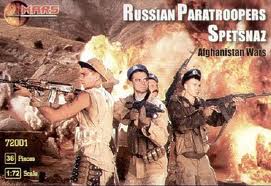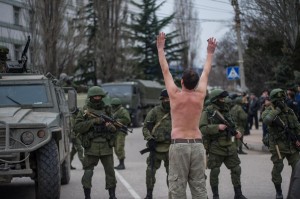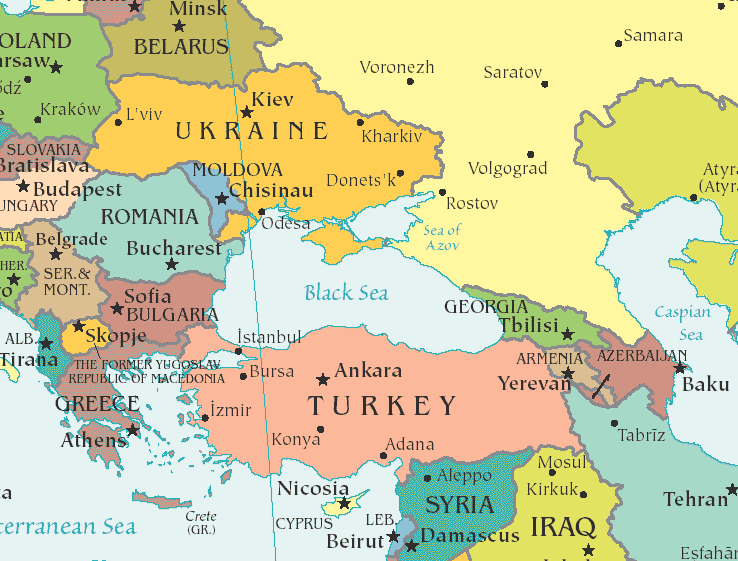Russia is accusing Ukraine of conducting an electronic attack on an orbiting communications satellite and is threatening unspecified retaliation as cyber warfare between the two states heats up over the crisis in Crimea.
Russia’s Ministry of Communications and Mass Media revealed Saturday that an electronic attack against a Russian television satellite was traced to Ukraine.
“Appropriate services have detected the exact location of the source in Ukraine’s territory,” the ministry said, according to state-run ITAR-TASS news agency.
The Russian ministry said the attempt to use “radio-electronic war means against a Russian relay satellite” violated the 1992 International Telecommunication Union charter.
A second Russian state-controlled news agency, Interfax, reported that the Ukrainians attempted to “decay” the orbit of the communications satellite. No details were provided. Some communications satellites can maneuver based on ground signals and apparently the unidentified source of the electronic attack sought to command the satellite to lower its orbit in an attempt to have it reenter the atmosphere and burn up.
James Oberg, a specialist on space issues, said there have been reports in the past of satellites being pirated by non-government groups for political purposes.
“Taking over a satellite to fire its engine and alter its orbit is an entirely different challenge and I know of no examples, nor do I expect any,” Oberg said in an email.
Oberg said one explanation for the Russian government statement about the satellite disruption is that it may have been an attempt by someone to fool the Russians into thinking the satellite’s orbit had changed and thus create confusion and mistrust of the data it is relaying.
“But here, as in all effective tactics, the target is the enemy’s decision loop, not his hardware,” he said.
“The people behind this decision should consider the consequences,” the Russian ministry warned Ukraine.
Disclosure of the satellite attack comes as both nations reported cyber attacks against government and non-government websites as the first phase of a new Cold War between Russia and Ukraine. The countries are currently embroiled in a conflict over Moscow’s invasion of Ukraine’s Crimea peninsula and Russia’s announced annexation of Crimea following a controversial independence referendum.
Ukrainian government spokesmen and cyber security analysts reported that Ukrainian websites in recent days were subject of sophisticated cyber attacks using malicious software called Snake. The software appears to originate from a nation state, leading to suspicions that Russia was behind the attack.
Snake software gives users covert capabilities to conduct cyber espionage in foreign computers and also can be used to conduct sabotage ranging from disabling networks to destroying data and hardware.
NATO’s Brussels headquarters reported experiencing a distributed denial of service attack on several public websites that was believed to be related to the Ukraine crisis. A NATO spokesman said the cyber attack did not disrupt operations of the military alliance. Distributed denial of service cyber attacks are sophisticated strikes that flood websites with requests using pirated computers that force systems to shut down.
Vice Adm. Mike Rogers, the nominee to be next commander of the U.S. Cyber Command, told Congress last week that Russia was conducting cyber attacks against Ukraine. “We clearly see that there’s an ongoing cyber element to the challenges in the Ukraine at the moment,” the three-star admiral told the Senate Armed Services Committee.
Rogers declined to provide specifics of the Russian cyber attacks but acknowledged that Moscow had developed very sophisticated cyber warfare capabilities and could inflict significant damage on Ukraine’s critical infrastructures, such as government and military communications networks and telecommunications networks.
He warned that “clearly cyber will be an element of almost any crisis we’re going to see in the future,” Ukraine’s government reported last week that several websites were affected by the cyber attacks, including the website of Ukraine’s National Security and Defense Council that was shut down March 4.
Apparent retaliatory attacks were launched against Russia on Friday. Reports in state-run media described the attacks as “powerful” and affecting the operations of the presidential administration website and Russia’s central bank.
A senior Air Force commander warned Congress last week of the growing threat to satellites from an array of attacks, including electronic jamming, cyber attacks, and anti-satellite missiles.
China demonstrated an anti-satellite missile in January 2007, destroying an orbiting weather satellite that left tens of thousands of pieces of debris floating in space.
Air Force Gen. William Shelton, commander of the Air Force Space Command, told a Senate hearing Wednesday that space warfare threats are increasing.
“Counterspace developments by potential adversaries are varied and include everything from jamming to kinetic kill anti-satellite weapons,” Shelton said in prepared remarks.
Electronic jammers capable of disrupting Global Positioning Satellites used in navigation and precision guidance for weapons are “widely available” as are satellite communications jammers.
“Also, some nations have developed and successfully demonstrated anti-satellite weapon capabilities which could threaten our satellites in times of conflict,” Shelton said in testimony to the Senate Armed Services strategic forces subcommittee. “Unfortunately, all projections indicate these threatening capabilities will become more robust and proliferated, and they will be operational on a shorter than predicted timeline.”
Under questioning, Shelton said U.S. missiles and spacecraft are vulnerable to attack.
“Yes, sir. We are going system by system, looking at our cyber vulnerabilities. And we have a large information assurance program that gets into those vulnerabilities and patches them and tries to prevent access. In many cases, these are closed systems. That doesn’t mean there aren’t vulnerabilities, but they are closed systems, not accessible through the Internet. So it would take insiders, special access, those kinds of things, to get to these closed networks. But nevertheless, we’re addressing all those touch points, if you will, in closing off those vulnerabilities best we can.”
Shelton said in January that satellite jammers are a “cheap and effective way of blocking our signals from space” and lasers “can blind our imaging systems, and in the future, they could prove destructive to our satellites.”
“Direct attack weapons, like the Chinese anti-satellite system, can destroy our space systems,” Shelton said.
Credit to Washington Free Beacon









